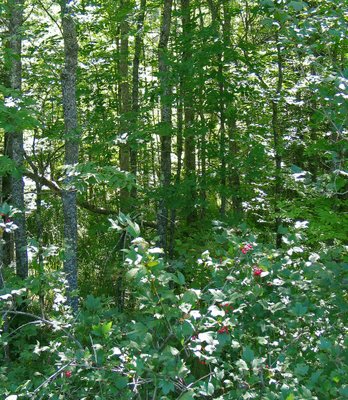Invasive Species I Love to Hate
 This was a tiny black dot flying over some tammaracky boggy land next to a lake. I've enlarged the photo - a lot. I'm grinning because I told Carolyn what it was after only hearing it vocalize. There are not many birds I can identify by their vocalizations. It's an osprey. Isn't it beautiful? I'm a transportation volunteer for the Raptor Center at the U of Minnesota, and one day I was hanging around the clinic after I delivered my bird while they were working on giving an osprey falsies for tail feathers, so she could practice flying before her tail feathers came in. I was nearly bowled over by the fish smell the bird gave off. If you are what you eat, this critter should have scales.
This was a tiny black dot flying over some tammaracky boggy land next to a lake. I've enlarged the photo - a lot. I'm grinning because I told Carolyn what it was after only hearing it vocalize. There are not many birds I can identify by their vocalizations. It's an osprey. Isn't it beautiful? I'm a transportation volunteer for the Raptor Center at the U of Minnesota, and one day I was hanging around the clinic after I delivered my bird while they were working on giving an osprey falsies for tail feathers, so she could practice flying before her tail feathers came in. I was nearly bowled over by the fish smell the bird gave off. If you are what you eat, this critter should have scales.
So that's why I'm grinning away in the picture below. I had started out our walk in a foul mood because the woods the side of the road were choked with European Honeysuckle. This is just outside of Ely, Minnesota up near the Boundary Waters Canoe Area Wilderness. The shrub in the foreground of the photo below with red berries is European Honeysuckle, sometimes called Tartarian Honeysuckle. There is native honeysuckle in Minnesota - a bush type and a vining type - but it looks nothing like the invasive honeysuckles (try something other than lonicera tararica, lonicera morrowii, lonicera x bella in your plantings).
The DNR (1.800.646.6367) publishes a great little resource, "Minnesota Invasive Non-native Terrestrial Plants: An Identification Guide for Resource Managers," full of pictures of the blooms, seeds and entire plants to be avoided and removed. Included are such plants as Japanese Barberry, Norway Maple, Queen Anne's Lace, and Amur Maple in addition to the ones you would expect to see like Common Buckthorn, Reed Canary Grass, Purple Loosestrife and Garlic Mustard. Many of the plants listed in this publication are still sold in nurseries, but so was buckthorn until recently. The DNR is trying to get the word out that these plants are harmful to the health of our native ecosystems and drive down the demand for the plants. That way when they are finally "outlawed," nurseries won't be stranded with a lot of inventory they can't unload.
Great alternatives are Slippery Elm, Nannyberry, Highbush Cranberry, Chokecherry, Arrowwood Viburnum, Witchhazel (blooms in October!), Leatherwood. Instead of Amur Maple, try planting Pagoda Dogwood - it is a native Minnesota plant and has better form without trimming, is less messy and will attract showy birds!
PS My name is Kathy Connelly. I'm a Hennepin County Master Gardener and I approve this message.

No comments:
Post a Comment